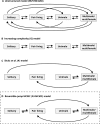Evolutionary transitions toward pair living in nonhuman primates as stepping stones toward more complex societies
- PMID: 32064318
- PMCID: PMC6989303
- DOI: 10.1126/sciadv.aay1276
Evolutionary transitions toward pair living in nonhuman primates as stepping stones toward more complex societies
Abstract
Nonhuman primate societies vary tremendously in size and composition, but how and why evolutionary transitions among different states occurred remains highly controversial. In particular, how many times pair living evolved and the social states of the ancestors of pair- and group-living species remains contentious. We examined evolutionary transitions in primate social evolution by using new, independent categorizations of sociality and different phylogenetic hypotheses with a vastly expanded dataset. Using Bayesian phylogenetic comparative methods, we consistently found the strongest support for a model that invokes frequent transitions between solitary ancestors and pair-living descendants, with the latter giving rise to group-living species. This result was robust to systematic variation in social classification, sample size, and phylogeny. Our analyses therefore indicate that pair living was a stepping stone in the evolution of structurally more complex primate societies, a result that bolsters the role of kin selection in social evolution.
Copyright © 2019 The Authors, some rights reserved; exclusive licensee American Association for the Advancement of Science. No claim to original U.S. Government Works. Distributed under a Creative Commons Attribution License 4.0 (CC BY).
Figures




References
-
- D. R. Rubenstein, P. Abbot, Comparative Social Evolution (Cambridge Univ. Press, 2017).
-
- Hughes W. O. H., Oldroyd B. P., Beekman M., Ratnieks F. L. W., Ancestral monogamy shows kin selection is key to the evolution of eusociality. Science 320, 1213–1216 (2008). - PubMed
-
- Cornwallis C. K., West S. A., Davis K. E., Griffin A. S., Promiscuity and the evolutionary transition to complex societies. Nature 466, 969–972 (2010). - PubMed
-
- Shultz S., Opie C., Atkinson Q. D., Stepwise evolution of stable sociality in primates. Nature 479, 219–222 (2011). - PubMed
-
- Lukas D., Clutton-Brock T. H., The evolution of social monogamy in mammals. Science 341, 526–530 (2013). - PubMed
Publication types
MeSH terms
LinkOut - more resources
Full Text Sources
Other Literature Sources

